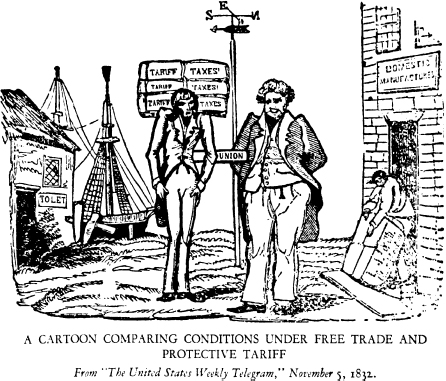America’s History: Printed Page 319
America: A Concise History: Printed Page 291
America’s History: Value Edition: Printed Page 283
The Last Notable President: John Quincy Adams
As president, Adams called for bold national action. “The moral purpose of the Creator,” he told Congress, was to use the president to “improve the conditions of himself and his fellow men.” Adams called for the establishment of a national university in Washington, scientific explorations in the Far West, and a uniform standard of weights and measures. Most important, he endorsed Henry Clay’s American System and its three key elements: protective tariffs to stimulate manufacturing, federally subsidized roads and canals to facilitate commerce, and a national bank to control credit and provide a uniform currency.
The Fate of Adams’s Policies Manufacturers, entrepreneurs, and farmers in the Northeast and Midwest welcomed Adams’s proposals. However, his policies won little support in the South, where planters opposed protective tariffs because these taxes raised the price of manufactures. Southern smallholders also feared powerful banks that could force them into bankruptcy. From his deathbed, Thomas Jefferson condemned Adams for promoting “a single and splendid government of [a monied] aristocracy … riding and ruling over the plundered ploughman and beggared yeomanry.”
Other politicians objected to the American System on constitutional grounds. In 1817, President Madison had vetoed the Bonus Bill, which proposed using the national government’s income from the Second Bank of the United States to fund improvement projects in the states. Such projects, Madison argued, were the sole responsibility of the states, a sentiment shared by the Republican followers of Thomas Jefferson. In 1824, Martin Van Buren likewise declared his allegiance to the constitutional “doctrines of the Jefferson School” and his opposition to “consolidated government,” a powerful and potentially oppressive national administration. Now a member of the U.S. Senate, Van Buren helped to defeat most of Adams’s proposed subsidies for roads and canals.

The Tariff Battle The major battle of the Adams administration came over tariffs. The Tariff of 1816 had placed relatively high duties on imports of cheap English cotton cloth, allowing New England textile producers to control that segment of the market. In 1824, Adams and Clay secured a new tariff that protected New England and Pennsylvania manufacturers from more expensive woolen and cotton textiles and also English iron goods. Without these tariffs, British imports would have dominated the market and significantly inhibited American industrial development (Chapter 9, America Compared).
Recognizing the appeal of tariffs, Van Buren and his Jacksonian allies hopped on the bandwagon. By increasing duties on wool, hemp, and other imported raw materials, they hoped to win the support of farmers in New York, Ohio, and Kentucky for Jackson’s presidential candidacy in 1828. The tariff had become a political weapon. “I fear this tariff thing,” remarked Thomas Cooper, the president of the College of South Carolina and an advocate of free trade. “[B]y some strange mechanical contrivance [it has become] … a machine for manufacturing Presidents, instead of broadcloths, and bed blankets.” Disregarding southern protests, northern Jacksonians joined with supporters of Adams and Clay to enact the Tariff of 1828, which raised duties significantly on raw materials, textiles, and iron goods.
The new tariff enraged the South, which produced the world’s cheapest raw cotton and did not need to protect its main industry. Moreover, the tariff cost southern planters about $100 million a year. Planters had to buy either higher-cost American textiles and iron goods, thus enriching northeastern businesses and workers, or highly dutied British imports, thus paying the expenses of the national government. The new tariff was “little less than legalized pillage,” an Alabama legislator declared, calling it a Tariff of Abominations. Ignoring the Jacksonians’ support for the Tariff of 1828, most southerners heaped blame on President Adams.
Southern governments also criticized Adams’s Indian policy. A deeply moral man, the president supported the treaty-guaranteed land rights of Native Americans against expansion-minded whites. In 1825, U.S. commissioners had secured a treaty from one faction of Creeks ceding its lands in Georgia to the United States for eventual sale to the state’s citizens. When the Creek National Council repudiated the treaty, claiming that it was fraudulent, Adams called for new negotiations. In response, Georgia governor George M. Troup attacked the president as a “public enemy … the unblushing ally of the savages.” Mobilizing Georgia’s congressional delegation, Troup persuaded Congress to extinguish the Creeks’ land titles, forcing most Creeks to leave the state.
Elsewhere, Adams’s primary weakness was his out-of-date political style. The last notable to serve in the White House, he acted the part: aloof, inflexible, and paternalistic. When Congress rejected his activist economic policies, Adams accused its members of following the whims of public opinion and told them not to be enfeebled “by the will of our constituents.” Ignoring his waning popularity, the president refused to dismiss hostile federal bureaucrats or to award offices to his supporters. Rather than “run” for reelection in 1828, Adams “stood” for it, telling friends, “If my country wants my services, she must ask for them.”
EXPLAIN CAUSES
Question
What were the successes and failures of John Adams’s presidency, and what accounted for those outcomes?